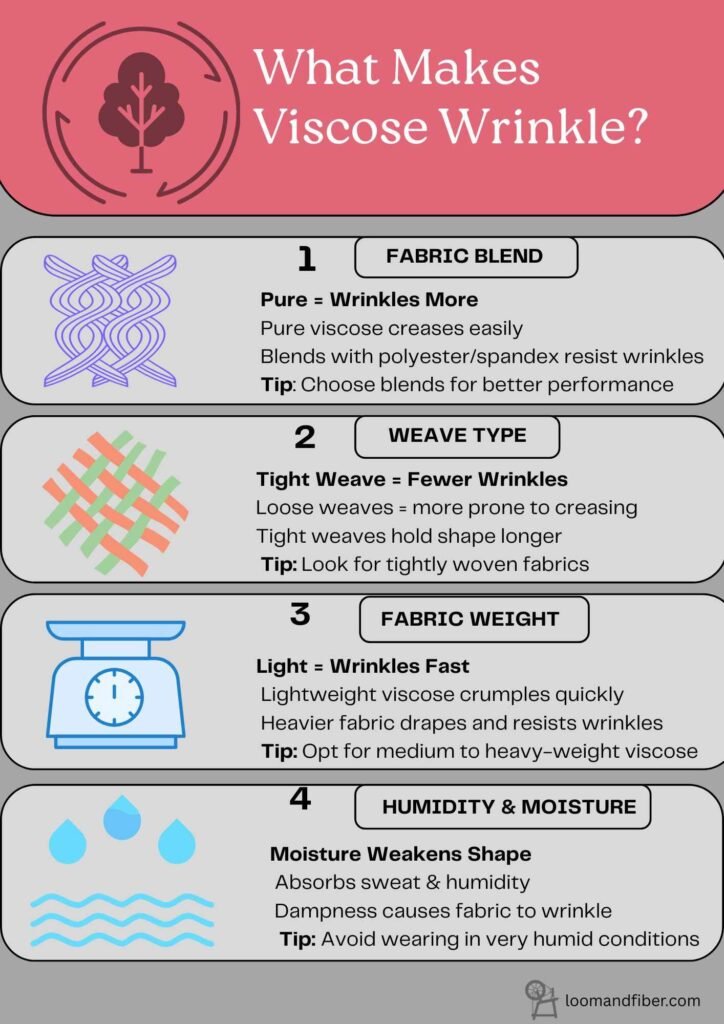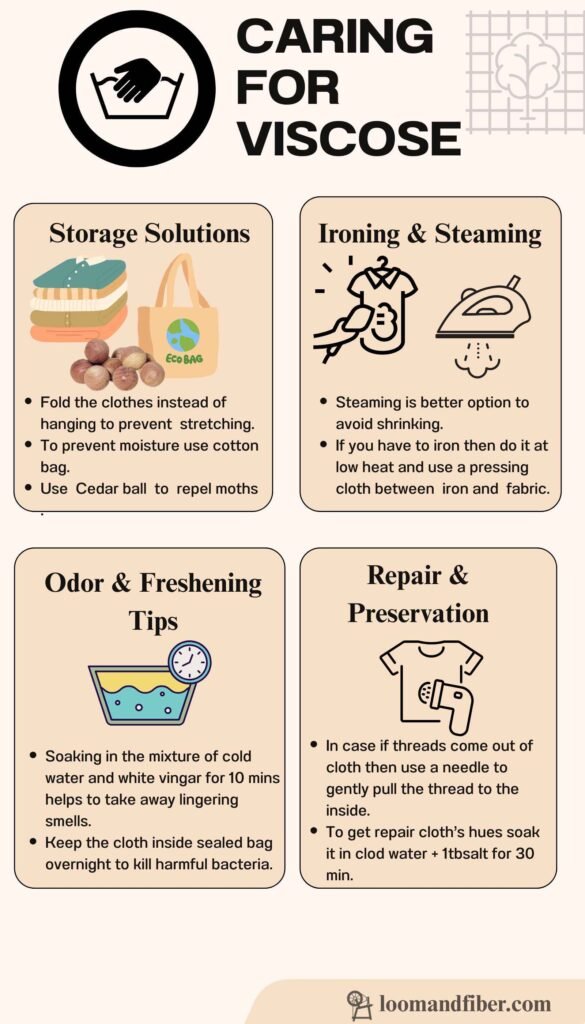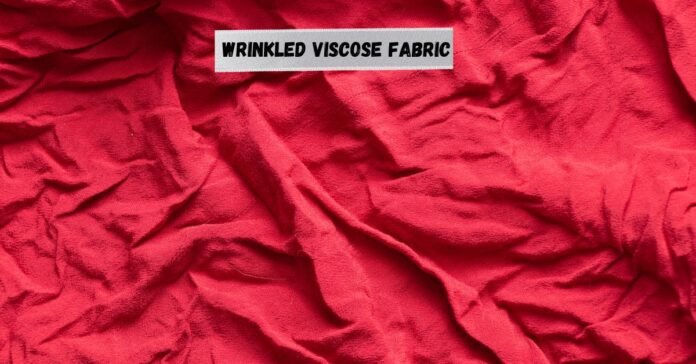Introduction: What Is Viscose and Why Is It So Popular?
Viscose is a semi-synthetic material made from regenerated cellulose, which is usually obtained from wood pulp. It imitates the softness and flowing drape of natural fibre such as cotton and silk, but is cheaper. Viscose is produced using a chemical process, belongs to the viscose fiber family and is often used in the fashion industry. Viscose is often found in everyday garments such as blouses, dresses, skirts, linings and lightweight scarves. Its luxurious feel and breathability make it the fabric of choice for both casual and formal wear. But although viscose feels fantastic, many people ask the same question: does viscose wrinkle easily?
Let’s get to the bottom of the answer — and, more importantly, what you can do about it.
Does Viscose Wrinkle Easily? Yes—Here’s How to Prevent It
Indeed, viscose is wrinkle-prone. This is because of its structure. Viscose is fashioned of cellulose, whose organic compound is also present in cotton and linen. Nevertheless, viscose fibers are more tender and absorbent and as a result are more subject to creasing.
Viscose is in the middle when it comes to comparison with other fabrics. It also becomes wrinkled in comparison to cotton that is designed in a much more sturdy manner. It does not however wrinkle as much as linen which is a well known crumpled and relaxed look. The lightweight and soft material is why viscose does not keep its shapes that well, especially when wet.
And so, as some people have experienced opening their suitcase and finding a viscose shirt that just looked like a bunch of used tissue, they are not just imagining this.
What Makes Viscose Wrinkle? 4 Key Factors
Many factors exist that shape up the tendency of viscose clothes to crease. In case you know them, you will be able to be more sensible and informed when shopping and working with your clothes.

1. Fabric Blend
A pure viscose wrinkles the most. Blended with other materials, such as synthetic fibers, e.g. polyester or elastane (spandex), however, it gains much more wrinkle-resistance. As an example, a blend of viscose and polyester can keep the tenderness of the viscose and also enjoy the wrinkle-free property of the polyester.
Therefore, blended fabrics are a good idea in case you want to be wrinkle-resistant.
2. Weave Type
The denser the loom the more the fabric keeps its shape. Viscose fabrics are loosely woven and they are delicate and prone to wrinkling. Tightly woven viscose things, such as the more expensive lining, however, crease less easily.
Close weaves prevent wrinkles as well as enhance durability of the fabric.
3. Fabric Weight
Viscose fabrics that are lightweight, like the ones worn as summer dresses, easily wrinkle. Heavier ones such as the ones in tailored jackets or blazers are more drape friendly and less wrinkling.
By and large, the denser the fabric, the more sturdy and non wrinkled it can be.
4. Humidity & Moisture
Viscose attracts the moisture around you and in your body. This exposes it to special vulnerability in humid climate. In a wet condition, viscose lacks shape and develops folds easily.
Even a bit of sweating or humidity will cause wrinkles which can be seen anytime, and they become especially evident in loosely fitting clothing.
How to Remove Wrinkles from Viscose (Tried-and-True Methods)
It is possible to remove the wrinkles out of viscose-you only have to know the techniques. The most secure and feasible ways are as follows.
Ironing Viscose: Handle with Care
Viscose can be ironed, but this should be explicitly handled. It should be operated on the low to medium heat and a thin cotton layer must always be put between the iron and the fabric to avoid scorching the cloth. It is also possible to loosen the fibers with the help of steam without touching them.
One should never iron viscose when it is totally wet because it may destroy the cloth.
Steaming: The Safe and Simple Method
Steaming a garment with a steamer is kinder to a garment as opposed to ironing. Put a little steam under it, a few inches away and it does the work. It is particularly useful with flowy dresses and sheer tops that are usually created with airy viscose.
Steaming does not just remove wrinkles, but also leaves the texture cool with no problem of a burn mark.
Hanging in a Steamy Bathroom
In case you are not able to use a steamer or iron, then a bathroom steaming shower can perform miracles. Put the crumpled viscose garment on a hanger or hook and take a hot shower (there is no need to switch on the vent). Be sure the thing is not under the full impact of the water but only hanging over in the steamy room. It will allow the steam to filter through the fabric very easily and aid in relieving wrinkles. Allow it to set 10, 15 minutes and then rub the cloth smooth by hands. It is a convenient hotel-room tip-off when it comes to viscose travel. Going back, though, it should be noted that, although this may be able to remove light creases, it may not be able to remove marks that are deeply buried wrinkles.
How to Prevent Viscose from Wrinkling
Prevention is better than cure. If you take care of your viscose garments right at the beginning, then you may never have to worry about deep creases.
Proper Washing
Wash at hand or on a delicate cycle of your machine. Never mix it with hot water and harsh detergent. Never squeeze out the fabric- press it with towels gently. When it comes to washing, it would be best to be careful with it and work with it in a gentle way not to wear it out or develop creases.
Drying Techniques
Viscose can be aired on a clean towel or air dried on a padded hanger. Take the garment wet and reshape it thereby decreasing the likelihood of wrinkles appearing. Also, do not use tumble drying unless it is on the lowest level.
Storage Tips
Viscose clothes should be folded or hanged neatly with padded hangers or shaped hangers. The use of wire hangers can put marks on them and make the material stretchy. And its shape and avoidance of the creasing in the long run can be made thanks to proper storage.
Travel Hacks
When you pack viscose during travel you should roll rather than fold your garments. This technique reduces severe creases. Travel-size wrinkle-release sprays may also be used to re-fresh your clothes. Put wrinkle prone items in bag of garments or alternate between layers of tissue papers.

Viscose vs. Other Fabrics (Wrinkling Comparison)
As compared to other common fabrics, how does the viscose fare as far as wrinkles are concerned? Comparing the wrinkling behavior of viscose with cotton, polyester and linen is hereby accomplished.
Viscose vs. Cotton
Viscose and cotton are both made out of cellulose, however, they behave differently. Cotton is a complete natural fiber and the viscose is semi-synthetic. Overall, cotton materials are heavier and they unfold faster. As an example cotton shirts or jeans will spring back and most cotton garments are found in easy care form as a reason. It is observed in one source that cotton is far less likely to wrinkle as compared to viscose. This implies that the average cotton will be more convenient when you wish to have a piece of clothing that will remain smooth throughout day at work. That aside, viscose is more silk-like to the touch and it flows more gracefully. Therefore, compared to cotton, viscose will crease more frequently, still, it has a smooth and shiny appearance. If you feel that the wrinkle-resistance is the most important thing then you may want to go with cotton (blended or treated cotton).
Viscose vs. Polyester
Polyester is a totally synthetic fiber; it is one that has quite good wrinkle resistance. Polyester items of clothes hardly require ironing because they just do not crinkle. Indeed, the reason things made of polyester are popular as travel clothes and suits is due to the fact that they are durable and wrinkle-free, at least easily. In comparison, viscose is not as long lasting and is more ready to wrinkle but viscose tends to be cooler and more breathable than polyester. The price to pay is comfort over maintenance: polyester is unlikely to cling or wrinkle and viscose falls more gracefully over the figure. In a real sense, a 100 percent polyester blouse will retain its smoothness even without taking care of it, a similar blouse made of viscose might crease once it has been seated. But what they can do is a blend of the two discussing later on.
Viscose vs. Linen
Linen is well (notoriously) known to wrinkle. Similar to viscose, linen is a breathable fabric, which is even more crease-prone. Linen is made of fiber of flax plants that is stiff and rough as viscose has smooth pulp fiber. It goes without saying that linen clothes will creak and fold every time they bend. A linen shirt or a pair of pants will collect wrinkles during the day and will acquire a casual, worn-in appearance, due to them. More drapey and smoother, viscose wrinkles not so spectacularly as linen, yet more than most people would possibly prefer. Simply stated above, in the ranking of wrinkle proneness: linen > viscose > cotton > polyester. Dark folds on linen are their beauty (some just adore the feel of it), and the gentle creasing of viscose can at times be just a quick press to avoid. In case you like linen, but would like to have less wrinkles, you might want to try out a linen-viscose mix, which will take part of the fancy rustling leaving it flatter.
Common Myths About Viscose Wrinkling
It is time to debunk some of the myths that usually confuse not only shopping enthusiasts but all the fashion enthusiasts as well.
Viscose Never Wrinkles – False
It actually is not true at all. Viscose can easily wrinkle and this happens mostly to the pure and lightweight viscose. Never expect the creasing not do be present in some scope.
You Can t Iron Viscose – Not Quite
You can absolutely do it, just do it with caution. Put a cloth barrier and use a low heat setting to prevent damage.
All Viscose Blends Wrinkle the Same-No
Blend is not always the same. A blend that is of a viscose and polyester fabric will get wrinkled a lot less than that involving viscose and linen. You should always read the label when you purchase.
Best Viscose Garments for Fewer Wrinkles
If you want the look and feel of viscose without constant ironing, there are certain types of viscose garments to favor. First, look for blended fabrics. Wrinkle-resistant viscose blends (especially with polyester or nylon) are widely available. Polyester-viscose blends are used in travel-friendly clothing because they “maintain a polished look” all day. Blazers, slacks, and even skirts made from viscose-polyester are excellent choices: they drape nicely yet smooth out easily after packing or wearing.
Second, choose structured styles or lined garments. Tailored pieces like jackets, structured dresses, and pant suits often incorporate interfacing or lining that helps the fabric resist creasing. A viscose blazer will typically wrinkle far less than a loose viscose sundress, because the construction holds its shape. Similarly, viscose garments with added spandex (stretch) will snap back better. For minimal wrinkles, stick with items labeled as “viscose blend” or “stretch viscose.”
Third, consider the item’s cut and fit. Flowy, gathered, or very lightweight styles naturally fold more. In contrast, viscose trousers or straight-cut skirts lie flat against the body and are less likely to bunch. A mid-weight viscose linen may look sophisticated yet require frequent pressing; whereas a thick rayon crepe pant will feel more stable. In summary, for hassle-free viscose, opt for blends and structured designs. If you love viscose’s drape, look for versions made specifically to be low-maintenance.
Conclusion-
Overall viscose is a gorgeous mixed synthetic fiber that is treasured because of its silkiness and fall. This is easily wrinkled, given the cellulose fibers it contains and the moisture it soaks up, though this is nothing very serious, given adequate care. It is useful to know the factors (blends, weave, weight, and humidity) so that you can select among the least wrinkly. In the event that they do develop wrinkles, these have to be steamed away or ironed out carefully. Viscose should be avoided in the washing machine and washed by delicate wash, hand wash, or to be creased-free; dry it lying down or on a padded clothes hanger or avoid wrinkles; because otherwise, it requires proper storage. When these best practices are adhered to, then you can be free to live the comfort of viscose without a crease crisis. Have your viscose tips or tricks? Post them to other readers below and ensure that your wardrobe remains as smooth as possible!
Read More>> About the shrinkage of modal fabric and bamboo fabric.
FAQs
Well, viscose is more prone to wrinkling: it absorbs more moisture and has higher porosity of the fibers.
Yes! One of the solutions to eliminate wrinkles on viscose garments is to use steam which is the safest and efficient method to clean wrinkles.
Steam, tumble dry lightly with a damp cloth, or hold it in a steamy bathroom.
Not always. When pure, viscose wrinkles, but when combined with polyester it can be worn on travel. Rolling your clothes several times is helpful in eliminating wrinkles.
